Today’s post is a wonderful piece of research by our dedicated project volunteer Kathy Nichols, who has an aptitude for historical research and always seems able to find a good story among our plates. Again, it is an example of how sometimes something which has a seemingly quite indirect connection to the subject of your research, leads you down a path that ends in an absolute goldmine of local history & you are left very glad that you were in a meandering mood! Kathy explains….
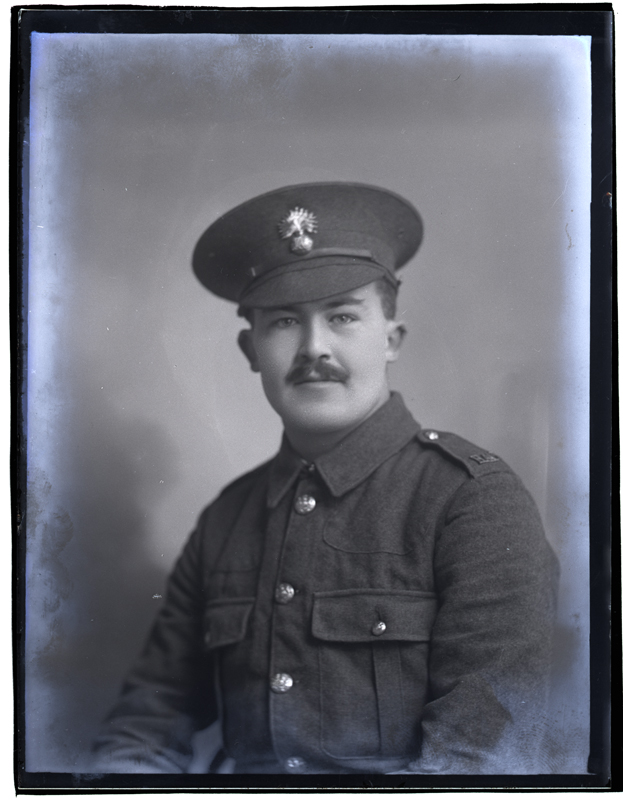
J A Chector, Esq. Photographed by Knights-Whittome, 9 Mar 1915
This story starts with one of our World War One glass plate negatives. The soldier in the photograph belonged to the Honourable Artillery Regiment (HAC). At first glance he looks like a Royal Fusilier but the H and A can be seen on the shoulder title and the cap badge is slightly different from that of the Royal Fusiliers.
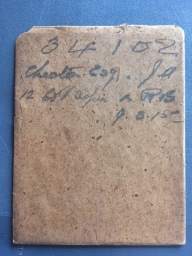 With the regiment established and an unusual name – J. A. Chector – we thought he would be easy to identify. This was not to be the case. There seemed to be no such surname. The name written on the negative envelope drew a blank. Eventually the problem was solved by using a mobile phone to photograph the name and then zoom in.
With the regiment established and an unusual name – J. A. Chector – we thought he would be easy to identify. This was not to be the case. There seemed to be no such surname. The name written on the negative envelope drew a blank. Eventually the problem was solved by using a mobile phone to photograph the name and then zoom in.
An alteration had made it hard to read. The soldier was found to be John Allford Cheston. The discovery of his identity led us to Hampton Lea, a house with very interesting residents.
It was a substantial house recorded as having twelve rooms in the 1911 census. It was on Langley Park Road situated towards the B&Q/ Carshalton Road end. The house name first crops up in 1888 in connection with a previous tenant but at present it is unclear when it was built, when it was demolished or if it still exists under another name or number.
Part 1: The Cheston Family
The High Achievers…
John Allford Cheston was an architect/surveyor whose family home was Hampton Lea from about 1908 until 1919 when they moved to Folke, Cedar Road, Sutton until 1926. Folke in Dorset was the birthplace of John’s mother; his grandfather was Rector there.
In the 1911 census he is living at Hampton Lea with his parents Horace and Alice Edith (née Allford) and sister Dorothy Ida (born 1895). His brother, Horace Charles Forbes Cheston, known as Forbes Cheston (born 1898), is at prep school in Eastbourne.
The wider Cheston family had quite a few noteworthy individuals. John’s father Horace and uncle Chester were also architects. Horace designed Ipswich Museum and many buildings in London, often banks with ornate facades. He was awarded the freedom of the City of London on 10th July 1911. Chester is noted for designing St Mark’s Church in Dalston, London E1.
Another uncle, Ernest, was a rugby international from 1873-1876. A cousin, Charles Sidney Cheston (1882-1960) was a notable Suffolk painter.
The Literary Connection…
An actress aunt, Dorothy Cheston, became the long term lover of the author Arnold Bennett and mother of his child in the 1920s. She seems to have been a difficult woman – after Arnold died of typhoid as a result of drinking tap water in Paris Bennett’s friend H G Wells commented, “She’s a bitch and she killed Arnold”.1
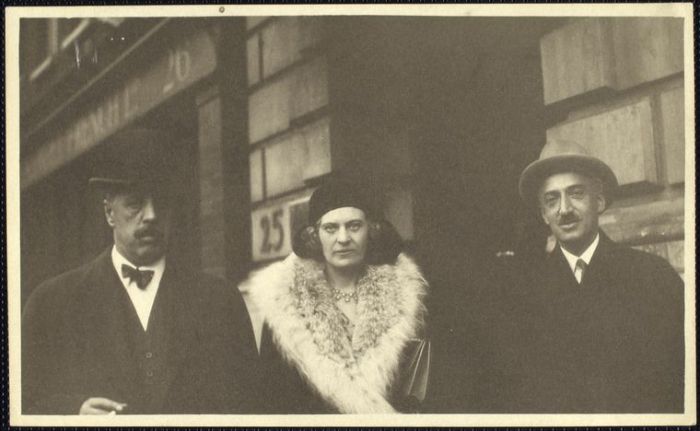
Dorothy Cheston ( Middle), Photographed with Arnold Bennett (Left). Image Copyright NYPL Digital Collections
Interestingly, H G Wells lived close to Hampton Lea at what is now 25 Langley Park Road in one of the houses then known as Cumnor Terrace. He is thought to have lived there in secret for some months in 1893-1894 with his lover Amy Catherine Robbins (later his second wife) before moving to Worcester Park. There is a Sutton Heritage Red Plaque on the house.
The Scandal in the Family…
Yet another uncle, solicitor Charles Cheston was the agent for William Thyssen-Amherst, 1st Baron of Hackney. John’s grandfather, Chester senior, had also filled this role. It may be that the family’s move from London to the relative seclusion of Sutton was partly related to the scandal caused by Uncle Charles. In 1906 he ruined Lord Amherst by gambling £281,000 worth of his property on the Stock Exchange. Lord Amherst was forced to sell a large part of his possessions to cover the loss. Charles committed suicide on 8th May 1906.
The Children Who Did Their Duty…
Back to our sitter…When it came to the First World War John Cheston and his siblings all signed up to do their duty. His sister Dorothy Ida doesn’t feature in many records but she is recorded by the Red Cross as being a civilian VAD on 8th July 1915 with her address given as Hampton Lea. She later married Captain Philip Ashley Hall, MC, DSO.
John served with the London Regiment in the Honourable Artillery Company. He was promoted from Corporal to 2nd Lieutenant on 23rd December 1915. His old school, Haileybury College, records on their website that he was a lieutenant with the 17th Battalion, Royal Fusiliers and made acting Captain with the 24th Battalion on 28th June 1918. The supplement to the London Gazette dated 1st Feb 1919 recounts the action which earned him the Military Cross:
During the attack on the strongly held enemy system about the Canal du Nord on the 11th and 12th September, 1918, he led his company deep into the hostile trenches, overcoming a fierce resistance and accounting for numbers of the enemy, besides taking, many prisoners. In the heavy bombardment of a counter-attack, he moved his men from the main trench to forward shell holes, thereby saving many lives as the trench was obliterated. His courage and leadership could be depended upon in any emergency.
He survived the war and continued his work as an architect and surveyor. Together with Charles E Elcock he designed the Bethlem Royal Hospital at Monks Orchard in Beckenham (now in the London Borough of Bromley). This is the fourth version of the psychiatric hospital originally known as Bedlam. He married Emelia Maria Chatrian in 1927. Sadly he died at the age of 41 on 24th July 1930, fifteen days after the opening of the hospital.
John’s brother, Horace Charles Forbes Cheston, had a different kind of war. He was very young when he joined up – in fact he was too young. Having been born in May 1898 he would still only have been seventeen when he was made temporary 2nd Lieutenant in the Cheshire Regiment in October 1915. The minimum age for enlistment was nineteen at the time but many young men lied about their age. He relinquished his commission less than a year later in August 1916.
A medal index card reveals that he served as a rifleman in the 5th London Rifles from July 1917 to January 1918 and then with the 28th London Rifles (The Artists’ Rifles) from January 1918 to August 1918. After the war he spent time in the USA and is recorded as having no occupation on various passenger lists. He married Mary Godley Starr (born in 1882 in Minnesota) in Berkshire in 1936.
Later he became an advocate for the progressive treatment of alcoholism. He felt that he had been rescued by Alcoholics Anonymous while he was in America and he encouraged the setting up of a British version over here. He also became the Secretary of the Interim Committee on Alcoholism.
By 1955 he had a business in London which offered interior decorating consultancy. On 13th February 1957 he featured on Woman’s Hour in the item “Forbes Cheston offers some thoughts on interior decoration”.
He wrote various pamphlets and items for magazines. He also wrote the book “Of Those Alone” using the pseudonym Robert Hutton (he was born in Hutton in Essex). Published in 1958 and subtitled “an autobiography”, the book described gay London in the years between 1918 and 1957. He and his wife lived in the Norwich area in their later years. She died there in 1974 and Forbes followed in 1975.
There we leave the Cheston family but there were two previous residents of Hampton Lea who also came to public notice. Unfortunately we haven’t discovered their portraits in the Knights-Whittome Collection but we’re sure you’ll want to hear about them…
Part 2: The Two Harriet(t)s
Harriet the Household Expert…
William John Fane de Salis and his wife Harriet Anne (neé Bainbridge) were the previous tenants. He was born in Maidstone, Kent in about 1834 and was a civil servant in the War Office. She was born in Hanover Square, London in about 1829.
Harriet was a clever woman. She was a keen genealogist and was a researcher for Oscar Browning, the writer, historian and educational reformer.

The Housewife’s Referee by Mrs de Salis Image Credit: Special Collections @ Virginia Tech Culinary History Blog
Writing as Mrs de Salis she was a popular author in the 1880s and 1890s. She wrote over twenty books including the series of à la mode books about cookery and household management. More can be read about her work as Mrs de Salis here.
She and her husband moved from Kensington and came to live at Hampton Lea by 1888 (she uses the address in the preface to “Dressed Game and Poultry à la Mode” which was published that year). In her book “Gardening à la Mode”, published in 1895, Harriet refers to the move saying “when we came to live in the country…..we had to make our garden which was only a field.”
The couple lived at Hampton Lea until their deaths – William died in 1904 and Harriet died in 1908.
Harriett the Fallen Woman…
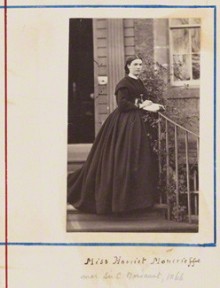
Harriet Sarah (née Moncreiffe), Lady Mordaunt by Unknown photographer © National Portrait Gallery, London
William and Harriet had a boarder who lived in the house from about 1888 until her death in 1906. Very few people would have been aware of her true identity and her notorious past. She was born Harriett Sarah Moncreiffe on 7th February 1848 in Perthshire, Scotland, the child of Sir Thomas Moncrieffe and Lady Louisa Hay-Drummond. She was one of sixteen children eight of whom were daughters known for their beauty.
She knew Queen Victoria’s eldest son Prince Albert (later the Prince of Wales and the future King Edward VII) as a child and when she was older she became part of the Marlborough House Set. Marlborough House was the London home of Prince Albert and his wife Princess Alexandra and the Marlborough House Set were the people they socialized with. Knights-Whittome photographed a group of them in their later years.
In their youth they had a reputation for high spirits and scandalous behaviour. In December 1866 Harriett, aged eighteen, married thirty year old Sir Charles Mordaunt, baronet and MP for South Warwickshire.
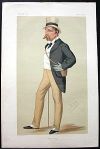 In June 1868 Charles returned home early from a trip abroad and found his wife unchaperoned contrary to a prior arrangement. Servants later confirmed that Lowry Cole, 4th Earl of Enniskillen had visited and been alone with her on a number of occasions.
In June 1868 Charles returned home early from a trip abroad and found his wife unchaperoned contrary to a prior arrangement. Servants later confirmed that Lowry Cole, 4th Earl of Enniskillen had visited and been alone with her on a number of occasions.
On 28th February 1869 Harriett gave birth to Violet Caroline Mordaunt who would grow up to become the grandmother of Henry Thynne, the sixth Marquess of Bath who first set up the Safari Park at Longleat.
Shortly after the birth, while her mind was in a disordered state, Harriett told her husband that the child was Lord Cole’s and that she had committed adultery with “Lord Cole, Sir Frederick Johnstone, the Prince of Wales and others often and in open day”.2
Charles discovered that his wife had received a number of letters from the Prince of Wales but they contained nothing of an intimate nature. He started divorce proceedings and not surprisingly the case caused a huge scandal damaging the public’s opinion of royalty and the upper classes generally. Harriett’s family claimed that she was insane following the birth and therefore unfit to plead her case. When the case came to be heard in February 1870 it made history as it was the first time a Prince of Wales gave evidence in open court. When questioned the Prince admitted meeting with Harriett while her husband was away but denied any criminal act.
In the end the jury agreed that Harriett was suffering from insanity caused by puerperal mania. The divorce petition was dismissed and she was committed to Manor Park Asylum in Chiswick. She would spend the rest of her life in seclusion – a total of thirty-six years.
Her husband was eventually granted a divorce in 1875 on the grounds of adultery with Lord Cole. In 1877 she was moved to Hayes Park Asylum, Hillingdon. She probably moved to Hampton Lea in 1888 – she appears there in the 1891 census as H S M, lunatic. She has an attendant. In the 1901 census she is Harriet Morgan, widow, feeble minded and with a lady’s maid. She died at Hampton Lea on 9th May 1906, her death certificate naming her as Harriet Mordaunt, widow of Charles Mordaunt, baronet.
Although Harriett had a tragic life, possibly unfairly deprived of her liberty, at least her family could afford to keep her in some of the very best asylums and private homes where the regimes were relatively relaxed with individual rooms, walks in spacious gardens and carriage rides. All over the country other less fortunate “inconvenient wives” were enduring the more harrowing conditions prevalent in Victorian asylums.
That’s the story of Hampton Lea so far – a suburban home, a rural idyll and a place of confinement. Anyone who can add to the story or correct any mistakes is, as always, welcome to contact us.
Sources: Ancestry: World War One Medal Cards, UK Collection Censuses, Passenger Lists, Probate Calendar; Google; (David H Clark (2000) How I learned My Trade); London Gazette; National Archives; Cooksinfo.com/harriet-anne-de-salis; Wikipedia: Harriet Mordaunt (Elizabeth Hamilton (1999) The Warwickshire Scandal)
Quotes: 1: Frank Swinnerton (1978) Arnold Bennett: A Last Word
2: Keith Middlemas (1975) Edward VII








I have been following this blog for quite a while. I know over a year. Although, I never get to read all of the stories, I do enjoy them when I find the time. I am so glad that you all take the time to find out a person’s story and share your findings. You all do a wonderful job.
LikeLiked by 1 person
Thanks Kelsee, your comments are much appreciated! Our volunteers work hard to uncover these stories and we think it is important that they are shared. Thank you for your continued support.
LikeLike
I was so excited to find this site. I had limited information about my distant cousin’s husband, Forbes Cheston, from England. I did a search, and found your blog. You were able to fill in so many blanks. Your hard work and dedication is greatly appreciated.
LikeLike
So pleased to hear this Shelley – this is exactly the kind of feedback that makes it worthwhile. Thanks for taking the time to comment.
LikeLike
Pingback: Of Those Alone – From Hampton Lea to NYC – The Forbes Cheston Story | The Past on Glass & Other Stories...
Thanks to Abby Matthews at Sutton Archives who told me about Horace Charles Forbes Cheston, known as Forbes Cheston (younger brother of John Allford Cheston), this blog and the book Forbes Cheston wrote under an alias of Robert Hutton. I managed to buy a copy of his 1958 book. It is a fascinating autobiography with names of people and some places changed. Sutton is not named but there are descriptions of journeys by train to London Victoria. According to the book Forbes actually enlisted (lying about his age) some months before he got his commission as a Temp 2nd Lieutenant. We are lucky that Professor John Crowley had a copy of ‘Of Those Alone’ with some notes indicating the real name of the author. Otherwise we may never have known the true identity of the book author Robert Hutton.
LikeLiked by 1 person